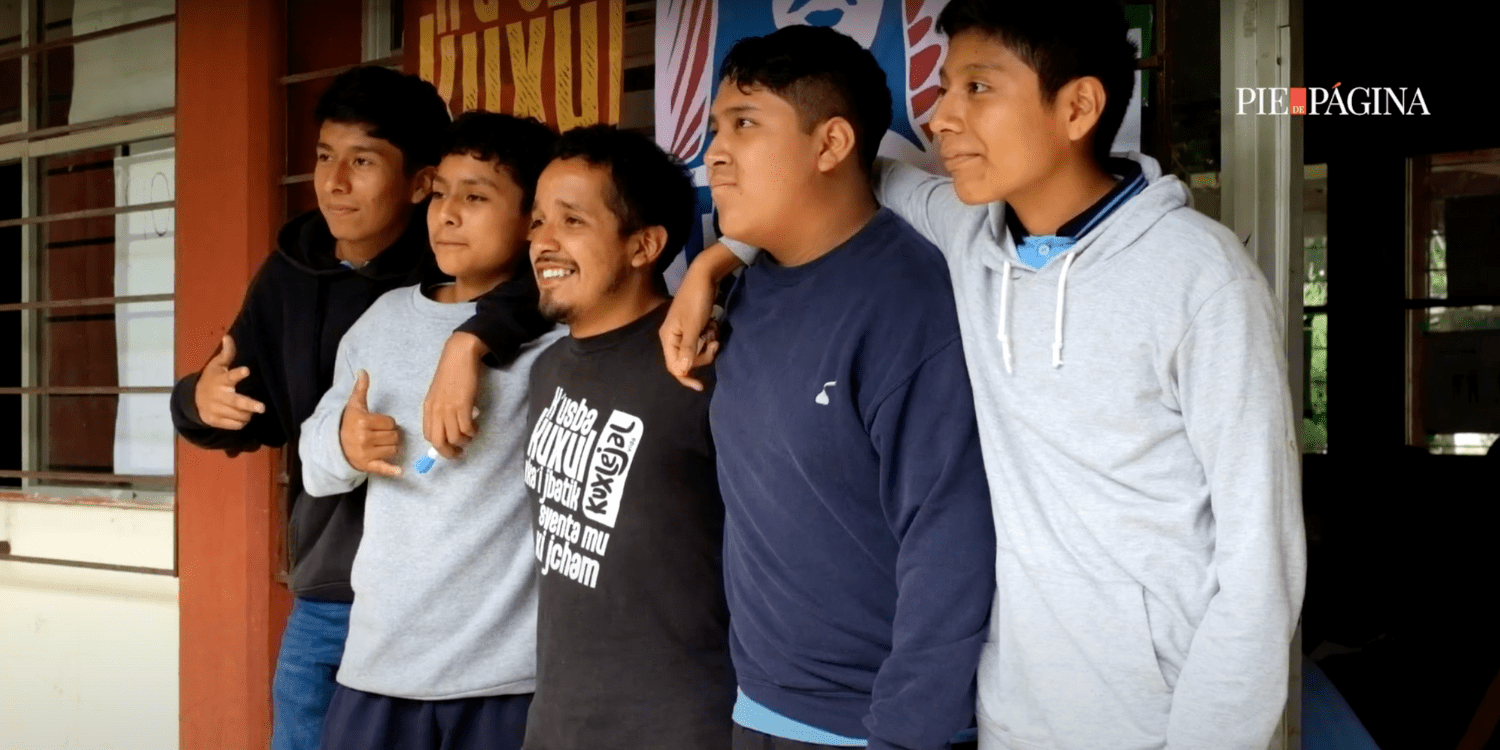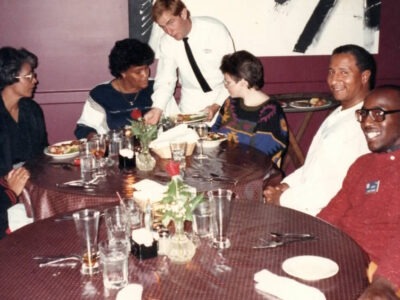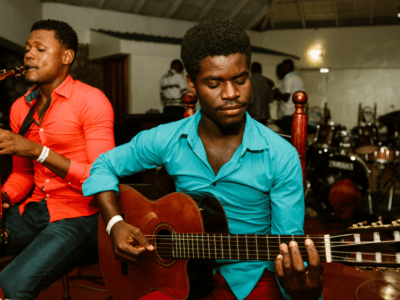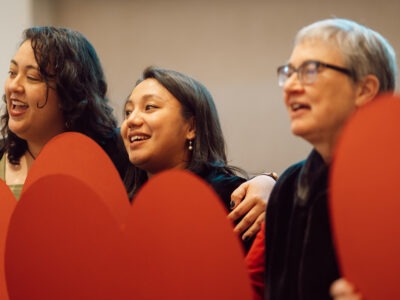This post is also available in: Español (Spanish)
The classroom is transformed into a makeshift movie theater for just one day. The light reflected from the projection illuminates 56 young faces as their gaze meets those of the characters on the screen, young people their age who share their features and language.
They’re at Technical High School 48 in Chenalhó, in the Chiapas Highlands, watching Kuxlejal, which in Tsotsil means “Life,” a documentary about teenage suicide in San Andrés Larráinzar, a town just 14 miles away. In one scene, two boys converse on the sidelines of a soccer field. One tells the other about their friend Araceli:
–Araceli was such a happy girl; we never saw her sad. But Alfredo died, and Ara felt lonely and took a turn for the worse, although she didn’t express it because she always tried to smile. “I’d like to go with Alfre,” she told me. “No,” I said, giving her advice many times. “Taking your own life isn’t the solution,” I told her. I looked after her for close to one week. I mean, we’d leave and stay together until she got home, and then I’d rest easier… Around nine a.m., Neo came by on his motorcycle; I heard the beep-beep. “Hey, Ara died,” he told me. She was still hanging there….
–How did you feel when you got there and saw her?
–Hell, it feels awful…it sucks. It destroys you. It’s a painful feeling. I couldn’t do a thing that day. Sometimes I think it was my fault; I feel that I didn’t know how to take care of her.
When the documentary ends, there’s some scattered applause. Humberto Gómez—Beto—the film’s producer, begins to speak in Tsotsil, the community’s native language. He asks who doesn’t understand, and four or five hands go up, so he speaks in Spanish.
—Who has a best friend?—asks Manuel de Jesús López— Chuy—one of the lead actors in the documentary.
Few raise their hands. The class is getting noisy. Chuy raises his voice so they can hear him.
—Who feels comfortable talking to their Mom or Dad?
Again, just five or six hands go up. The students’ shyness and the noise in the room hold the discussion back. But after a year and a half of visiting schools, Beto and Chuy have learned to respect the silence with which most of them hold in their feelings.
Outside, the tree branches sway with the wind, and behind the classrooms and the school field tower, enormous mountains are outlined by an intense blue sky with wisps of clouds.
Chuy is 24 years old, with a sad expression and a bright smile. Originally from Larráinzar, he’d like to be like Dr. Dre, the African American record producer who came from a violent neighborhood and became a hip-hop star.
“I’ve had suicidal thoughts for a long time,” he says, “I’d say that the most important thing for us to work on is our emotions and how to express them. I believe that life offers you many alternatives to express yourself; you just have to find them.”
According to the National Institute of Statistics and Geography (INEGI), self-inflicted death is the fourth leading cause of death among young people in Mexico, and Indigenous communities are no exception. A study by the Autonomous University of Chiapas revealed that from October 2012 to April 2013, six towns in the Chiapas Highlands reported six suicide attempts per month. The WHO has reported that suicide rates are high among vulnerable and marginalized groups, such as the Tsotsil Indigenous communities of the Chiapas Highlands, where Larráinzar and Chenalhó are located.
It was there that Vientos Culturales, an organization that has been working with Indigenous children and young people for the past three decades, and to which Beto and Chuy belong, prepared a report on the issue. It was 2017, and the young people interviewed shared their thoughts:
–I think it’s not knowing how to release emotions, not with whom, not when, not how. It’s as if our society itself labels us as I don’t know what, and well, it’s something that, the more you can put up with it all, you’re like more of a man, and when you feel that you can’t do it anymore, you decide to kill yourself, to take your life.
–I don’t trust the people I used to talk to. Sometimes I want to tell them what I want to do, but they think I’m crazy. But now I’m fine. It’s good to live life. I want to sing; sometimes I write songs.
In the community, they believe that those who take their own lives are lost souls who don’t go to heaven, Beto says. They don’t consider it a social problem; they attribute it to a diabolical influence and eventually normalize it; they don’t associate it with alcoholism or lack of intrafamily communication. After that report, Vientos Culturales delved further into the problem through the documentary Kuxlejal (2020), which opened the door to the conversation.
***
In 2022, another stage of the Kuxlejal project began: visiting schools, screening the film and opening a conversation about teenage suicide in the region. Here, at Technical High School 48 in Chenalhó, after watching the documentary, Beto and Chuy pass out a survey to the group titled, “What’s your life like?” It reads: “In my life…” proposing the following options:
They hit me. They push me. They threaten me. They call me names. They forbid me from speaking Tsotsil. They make up harmful rumors. They reject me. Each student reads the sentences and circles a possible answer: Never. Sometimes. Always.
Sentence 23 reads: I’ve tried to kill myself. Someone circles the word “Always.”
The survey helps reveal student perceptions of harmful behaviors where they live, such as threats, rejection, or sexual abuse; self-injurious behaviors, such as hurting or cutting themselves or attempting suicide; and direct or indirect harm, such as withholding food or money, or forbidding them from speaking Tsotsil.
But “we don’t just stop at the harmful part,” says Martín Plascencia, the Autonomous University of Chiapas psychologist who designed the survey. “We also ask about prosociality, the actions or behaviors done without the need to do them.”
This involves phrases such as supporting, defending, sharing, teaching, inviting to play, listening, and concern for others.
Once they complete the survey, Beto proposes a game in which they share words about how the documentary made them feel, such as loneliness, problems at home, life, introspection, depression, don’t kill yourselves over anything; before you do something like that, you have to talk it through to find a solution. The last kid doesn’t say anything. It’s not easy to answer questions that personal and profound posed by strangers, with all eyes upon him. Once again, Beto and Chuy validate the silence.
***
Vientos Culturales found that one of the apparent causes of self-inflicted death is the fear of gossip. Because they don’t say “bullying,” they say “gossip.” Fearing betrayal and “hurtful jokes,” they opt for silence because they find no empathy. “There’s a lot of disempowerment within families and all kinds of violence, abuse, sexual harassment, unwanted pregnancies, serious problems,” says Elke Franke, director of the documentary.
In his analysis of young Indigenous people in Larráinzar, Alan Federico Barrientos of the Autonomous University of Chiapas found that “in the Tsotsil language, ‘youngster’ is a way of referring to those who are not married and have communal obligations. Young people hold marginal positions; they represent immaturity, insignificance, inexperience, and lack of prestige. A young unmarried person is not recognized as an important part of the community.”
However, Barrientos notes that education and globalization have reconfigured the community context, building a new conception of this age group; although “these young people are not entirely free from cultural demands, they respond to the norms and impositions of their community,” such as marriage at an early age.
Vientos Culturales found that accelerated modernization created a gap in intergenerational communication leading to discrimination against adolescents and young people who want to experience the globalized world they see on their cellphones. It’s an identity crisis in which the new generations need spaces for expression or coexistence, where they are valued and can experience life without suffering discrimination, thus preventing them from resorting to addictions, which have a strong presence in their lives beginning in middle school.
***
After the break, Beto and Chuy greet the students of Chenalhó with a new activity: to write down “something you’d like someone to say to you and that would make you happy.” The instructions make them recognize that there are words they need to hear that have never been spoken. They write anonymously, put their scrap of paper in a bag, and then take out someone else’s paper to read it aloud: “My wish is that someone would wish you well in school,” reads the first boy, and then the rest. They’re simple wishes, such as “I love you,” a kiss, an acknowledgment, “wish me luck,” and “be happy.”
“Kuxlejal has been a tool to break this shell around the heart in the face of all these circumstances, to create a loving, empathetic environment and a space for dialogue,” says Elke. Although they’ve also learned that “before dialogue, before speaking, there’s silence. And when kids don’t talk, it’s like the first step.”
At the end of the day, Beto and Chuy hand out construction paper and ask the students to draw or write a message about Kuxlejal: they draw the outline of their hands, trace a heart, copy an image from their cellphone, crumple up pages, repeat, form groups; someone slips out of the room. Beto then takes photos to upload to Kuxlejal’s social media and inspire more young people like them. Kuxlejal wants to change the narratives of their own stories; if the common consensus is, “My life is worthless, I’m alone,” changing that to “My life is worthwhile, I’m not alone.”
However, the work of Vientos Culturales is not a substitute for the government’s responsibility to provide timely and culturally relevant mental health care and put an end to the criminalization of Indigenous youth.
***
As Beto unplugs the projector in the classroom, Chuy and Nepstor, a project volunteer, prepare a concert sample of the rap and hip-hop workshops they give as a space for expression and creation in the Tsotsil language. “Music, I don’t know, maybe it could be a superpower, it’s not like saving the world, but maybe it saves lives,” Chuy says.
At the end of the concert, the school empties in silence. Perhaps, as Elke says, this silence, their silence, is a first step, a seed from which a word, a song, a phrase never before spoken will emerge and console, heal and be present. Hopefully.
***
*On the project page, you can download the film, the teacher guide, and the survey. In 2022 alone, this project directly impacted 1,800 middle and high school students in the Chiapas Highlands. In the municipal seat of Larráinzar, the town where it all began, there was not a single suicide in 2023.
This report is part of a Periodistas de a Pie series funded by the W.K. Kellogg Foundation






Comments